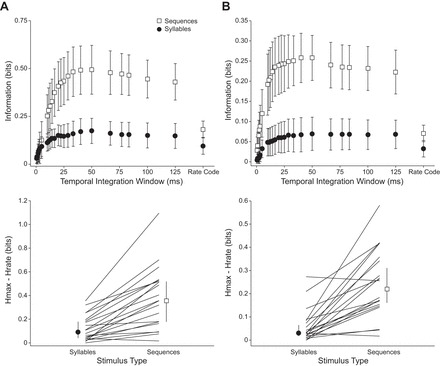Fig. 12.

Comparison of neural coding strategies based on spike distance metric. A: discrimination among vocal stimuli. Top: information for discriminating among syllables and sequences across a range of temporal integration values. Error bars show 95% confidence intervals. Bottom: difference between information at best temporal integration value (Hmax) and information in rate code (Hrate), for both syllables and vocal sequences. Vocal sequences carried more information than syllables in the rate code and gained a significant amount of information when the timing of spikes was considered. The amount of information gained from timing information was significantly different for syllables vs. sequences (Wilcoxon rank sum test, P < 0.001). Error bars show 95% confidence intervals of the median. B: discrimination among behavioral contexts associated with vocal stimuli. Top: information for discriminating among the contexts associated with vocal stimuli (biosonar, appeasement, lower aggression, and high aggression) for syllables and sequences across different temporal integration values. Bottom: difference between context discrimination information at best temporal integration window for syllables and sequences. Context discrimination information was higher in response to vocal sequences when spike timing was considered, and spike timing information contributed more to discrimination among behavioral contexts in response to sequences than syllables (Wilcoxon rank sum test, P < 0.001).
